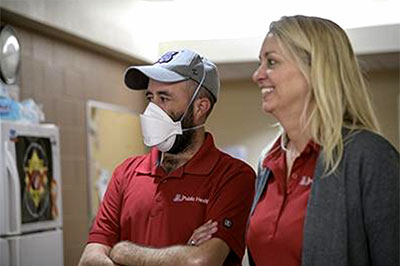Training Video for First Responders: How to Prevent Infection During an Outbreak
Faculty Expertise Helps First Responders Stay Safe
Story by Anna C. Christensen, UAHS Communications
The College of Public Health’s faculty has taken the initiative to support first responders. Kelly Reynolds, PhD, chair of the Department of Community, Environment, and Policy, and director of the Environment, Exposure Science, and Risk Assessment Center (ESRAC), worked with doctoral student Amanda Wilson, the Tucson Fire Department, plus Erich Healy and other personnel from the Western Regional Public Health Training Center (WRPHTC) to create a training video for firefighters and EMS responders.
Since the infection prevention training video was posted on YouTube on March 21, the training has proven very popular and thousands have viewed the training, more than any training video ever posted by the WRPHTC. All those views mean that thousands of first responders are prepared to avoid infection during the COVID-19 outbreak.

On a recent Tuesday afternoon, Dr. Reynolds accompanied a videographer to the fire station and watched as firefighters demonstrated for the camera how to protect themselves when treating a patient exhibiting symptoms of COVID-19 infection. Jonathan Sexton, PhD, ESRAC research specialist, played the role of a coughing patient, while the firefighters donned protective gear, put a barrier between the patient and the gurney, and carried out proper decontamination procedures afterward.
“The coronavirus caused fear and uncertainty about what best practice looks like,” Dr. Reynolds said. “The Tucson Fire Department contacted us to develop the video, to refresh our first responders about the importance of infection control protocols and make sure they’re doing things properly.”
Even when there aren’t outbreaks to worry about, first responders always need to be cognizant of germs to keep their patients — and themselves — healthy. COVID-19 offered a timely justification for a refresher course.
“You can pull out COVID-19, you can put in H1N1. You could pull out H1N1, and you could put in other ones — meningitis, tuberculosis. We treat them all the same way,” said Tucson Fire Health and Safety Captain John Gulotta, who sees the training as another opportunity to ensure firefighters stay educated. “We rely on the University of Arizona Health Sciences for help on how to reduce exposure, how to reduce contamination, and how to reduce germs getting into our station or our living space.”
COVID covid coronavirus virus covid19 corona

